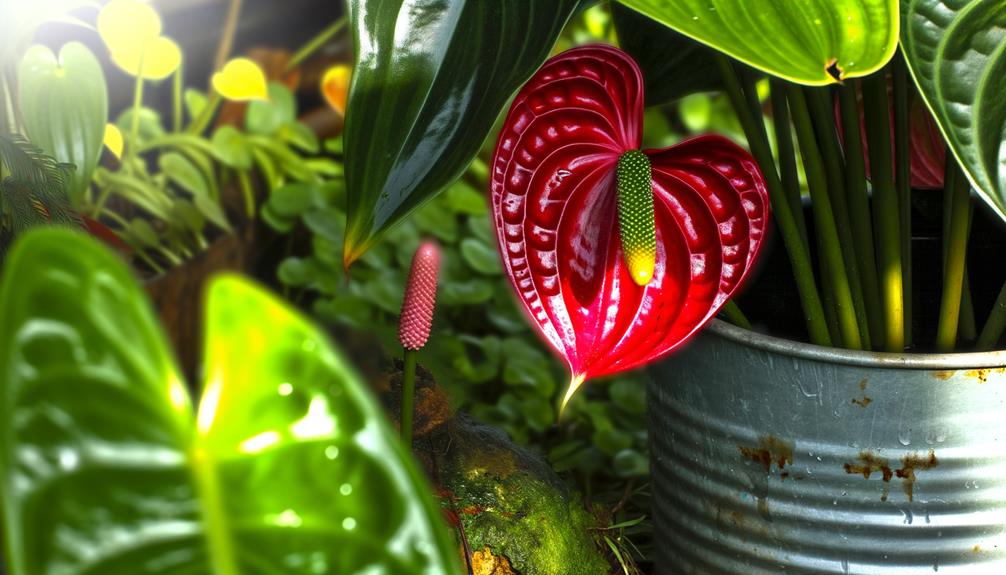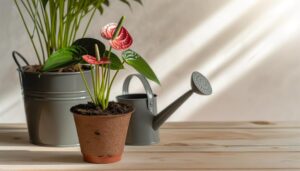5 Easy Steps to Grow Beautiful Anthurium Flowers
To grow beautiful Anthurium flowers, start with a well-draining potting mix containing orchid bark, peat moss, and perlite. Place your plant near an east-facing window with sheer curtains for diffused light.
Water the Anthurium when the top 1-2 inches of soil are dry, and use distilled water to avoid mineral buildup. Maintain temperatures between 70°F and 85°F, and keep humidity around 60-80%.
Finally, fertilize every 6-8 weeks with a 20-20-20 water-soluble fertilizer at half strength. By understanding these basics, you're well on your way to mastering the care of Anthurium flowers.

Key Takeaways
- Use well-draining potting mix with orchid bark, peat moss, and perlite.
- Place near an east-facing window with bright, indirect light.
- Water when the top 1-2 inches of soil are dry, ensuring proper drainage.
- Maintain temperatures between 70°F and 85°F with 60-80% humidity.
- Fertilize every 6-8 weeks using a diluted 20-20-20 water-soluble fertilizer.
Choose the Right Soil
To guarantee your anthurium flowers thrive, you must select a well-draining potting mix that replicates their natural tropical habitat. Start with a base of orchid bark, which provides aeration and drainage.
Mix in peat moss to retain moisture without waterlogging the roots. Adding perlite or pumice enhances soil aeration and prevents compaction. You can also include some charcoal to absorb toxins and maintain soil health.
Aim for a slightly acidic pH level, around 5.5 to 6.5, to optimize nutrient uptake. Ensure the mix remains loose and airy, as compacted soil can lead to root rot.
Optimal Lighting Conditions
Ensuring your anthurium flowers receive bright, indirect light will promote robust growth and vibrant blooms. Direct sunlight can scorch their leaves, leading to photodamage and reduced photosynthetic efficiency.
To achieve ideal lighting, you should:
- Place your anthurium near an east-facing window: This provides morning sun that's gentle and beneficial.
- Use sheer curtains: They diffuse intense sunlight, preventing leaf burn while maintaining adequate illumination.
- Implement artificial grow lights: If natural light is insufficient, full-spectrum LED grow lights can mimic sunlight.
- Rotate the plant regularly: Ensuring all sides receive equal light exposure helps maintain symmetrical growth.
Proper Watering Techniques
Watering your anthurium correctly is essential for preventing root rot and ensuring best nutrient uptake. To achieve this, you should maintain a balance between moisture and aeration. Water your plant when the top 1-2 inches of the soil feel dry. Ensure the pot has adequate drainage to prevent waterlogging. Use room temperature, distilled water to avoid chlorine and fluoride damage. Mist the leaves occasionally to mimic the plant's native humid environment.
Here's a quick reference guide:
| Action | Frequency |
|---|---|
| Watering | When top 1-2 inches dry |
| Checking soil moisture | Weekly |
| Ensuring pot drainage | Every watering |
| Using distilled water | Always |
| Misting leaves | Bi-weekly |
Ideal Temperature and Humidity
Maintaining the ideal temperature and humidity is crucial for the best growth and vibrant blooms of your anthurium.
You should aim to keep your plant in an environment that mimics its natural tropical habitat. Specifically, anthuriums thrive in temperatures between 70°F and 85°F (21°C to 29°C) and humidity levels around 60-80%.
Here's what you need to do:
- Use a hygrometer to monitor humidity levels regularly.
- Place a humidifier near your plant to maintain optimal humidity.
- Avoid drafts and sudden temperature changes, which can stress the plant.
- Group plants together to naturally increase humidity through transpiration.
Fertilizing Your Anthuriums
To promote healthy growth and vibrant blooms, apply a balanced, water-soluble fertilizer to your anthuriums every six to eight weeks. Choose a fertilizer with equal parts nitrogen (N), phosphorus (P), and potassium (K), such as a 20-20-20 formulation. Dilute it to half the recommended strength to avoid root burn. Make sure the soil is moist before application to facilitate nutrient absorption.
Pay attention to micronutrients like magnesium, calcium, and iron, which are essential for chlorophyll production and overall plant vitality. If leaves exhibit yellowing or stunted growth, adjust your fertilization routine accordingly.
Conclusion
By following these five steps, you'll grow anthuriums that are the jewels of your garden.
Choose the appropriate soil to build a strong foundation, provide ideal lighting to let them bask, water them just enough to quench their thirst, maintain perfect temperature and humidity for their comfort, and fertilize to fuel their growth.
Your anthuriums will flourish, their vibrant colors and lush leaves a proof of your green thumb and meticulous care.






